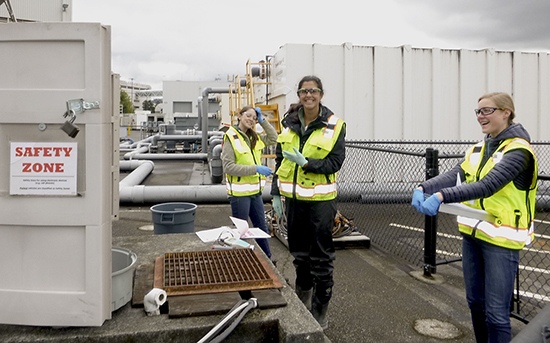|
Subscribe / Renew |
|
|
Contact Us |
|
| ► Subscribe to our Free Weekly Newsletter | |
| home | Welcome, sign in or click here to subscribe. | login |
Environment
| |
 |
September 27, 2018
Survey: Landau Associates

Specialty: Environmental remediation and engineering, geotechnical engineering, permitting and compliance services
Management: Jerry Ninteman, principal, remediation services director; Chip Halbert, principal, environmental permitting director; Calvin McCaughan, principal, geotechnical services director
Founded: 1982
Headquarters: Edmonds with offices in Seattle, Tacoma, Olympia, Spokane, Portland
2017 revenues: $16 million
Projected 2018 revenues: $17 million
Current projects: Geotechnical and industrial wastewater system design, air quality permitting and construction management for a central Washington data center campus; environmental investigation for cleanup and redevelopment of an airport property owned by Snohomish County; design and monitoring of a stormwater system at a Seattle aerospace facility
Jay Bower, principal and CEO of Landau Associates, answered questions from the DJC about his company and the industry. Answers have been edited for length and clarity.
Q: What is the biggest environmental issue in real estate?
A: Uncertainty. Real estate purchase and development is largely a strategic and financial decision. Potential environmental issues that may introduce uncertainty to a real estate project include unidentified or poorly characterized contamination, the presence of hazardous building materials in existing structures, lack of a clear process and timeline for regulatory agency interactions, and/or not having clearly allocated environmental liabilities.
We apply our experience and agency relationships to help clients accurately define potential liabilities, which minimizes uncertainty and helps them to make informed decisions.
Q: Your website says Landau is interested in teaming with WMBE firms. Why?
A: We have completed more than 300 projects since 2007 that involved a directly contracted WMBE teaming partner.
Some clients specify goals or requirements for participation of women- and minority-owned businesses to qualify for work so we need to have a grasp of the WMBE expertise available to build a winning team. Many WMBEs are not that known in the business community because they get plenty of work from just a few key clients. So we encourage them to contact us.
We want to develop relationships in advance of building project teams; the better we know each other, the more effective we’ll be. As importantly, people with the initiative to start small businesses, including WMBEs, frequently make great partners and mesh well with our collaborative, team-based approach to projects.
Q: What are trends in your industry locally and with your company?
A: The availability of talent to meet the demand for environmental services in this vibrant economy is an increasing constraint on growth — I’m unaware of any firm that isn’t hiring. Retention of talented staff is critical and competition for seasoned professionals is fierce.
As a 100 percent employee-owned firm, we focus on creating an environment where our staff can excel professionally and be rewarded financially as co-owners, with the result that we enjoy longer-than-average tenures. But we do not assume today’s employees want the same workplace experience as those in the past.
The focus on employee experience is increasingly critical to the success of environmental firms.
Q: Which services are most in demand and where do you see growth in the next five years?
A: Demand continues for services related to legacy environmental issues at brownfield and operating sites associated with re-use of underused land or expansion at existing facilities, but demand for services related to management and protection of land, water and air resources is growing more rapidly.
The regulatory environment for these projects is increasingly complex, and in some cases restrictive, and tends to create uncertainty from the owner’s perspective. Uncertainty can kill a project if there is too much perceived risk or a lack of confidence in the development schedule. However, the ability to mitigate for uncertainty through expertise and relationships with regulators and other stakeholders can create a competitive advantage for our clients.
Given the long-term trend in regulatory development and stakeholder interest, we expect to see continued growth.
Q: Is the rise of infill development in the Seattle area affecting what your firm does?
A: Most of our clients’ operations and development activities are outside of Seattle. There is likely some shift in the competitive environment related to the intensity of development in Seattle, but the overall economy has a much larger influence on our firm.
From our perspective, the vibrant economy has provided a wealth of work for everyone and it engages all our services, from managing legacy environmental issues to geotechnical engineering and permitting for new construction.
Other Stories:
- Infiltration maps streamline land-use planning
- Survey: O’Brien & Co.
- Survey: Shannon & Wilson
- Survey: Paladino & Co.
- Facebook’s new home will have 1st Salmon Safe woonerf
- Bold actions are needed to save local orcas
- Accelerating cleanup with adaptive management
- 10 years later: Weber Thompson’s HQ is better with nature
- More buildings set their sights on net zero
- State helps turn brownfields into affordable housing
- Survey: Parametrix


